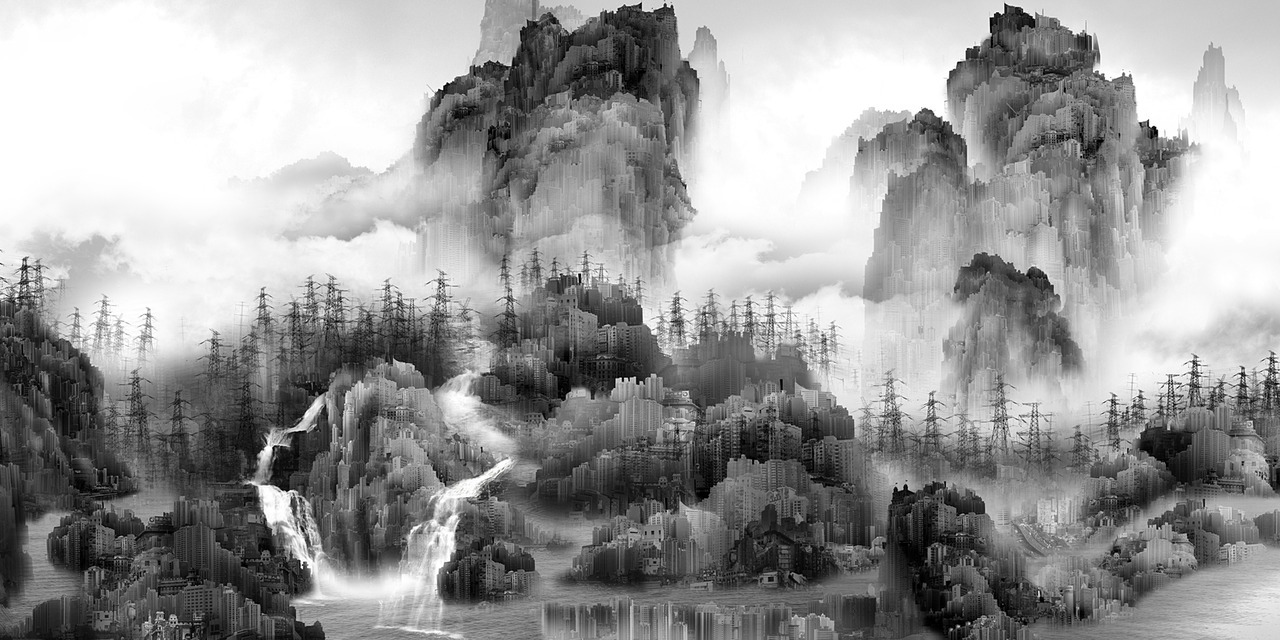

Fascinantne digitalne fotokolažne fuzije klasičnog kineskog pejzažnog slikarstva i suvremenih kapitalističkih mutacija koje proždiru Kinu. Vrlo filmično - kako bi Kinezi iz 13. stoljeća napravili filmsku obradu Tolkiena smještenu u budućnost.
Yang Yongliang’s Artificial Wonderland
Every now and then I come across something that takes my breath away. And recently, I’ve found this happen more and more with contemporary Chinese artists. Q regulars may remember the powerful impact of Xu Bing’s work with his meaningless words. Well here’s another…As this picture above illustrates, Chinese classical art is world-renowned for its stunning landscape painting (especially for the ways that the natural world is evoked by the slightest of brushstrokes).
But check this out.
Here are a few variations on the theme by the remarkable artist, Shanghai-based Yang Yongliang. At first sight, they seem to follow closely the path and styles of the old masters. But look closer – and you see that all is not as it first seems – for a start, they’re actually produced on an inkjet printer. Then he’s presented an incredibly powerful subversion of the style, as a way of exposing the way that aggressive capitalism and environmental exploitation have destroyed so much of the uniquely beautiful Chinese landscape.
No wonder that they have been appropriated by the China Environment Protection Foundation. No idea who or what they’re like, but i sure hope they’re able to stop at least some of the insanity.
Artificial Wonderland by Yang Yongliang
- markmeynell.wordpress.com

Heavenly City, by Yang Yongliang: Heavenly City 2
Photographer #205: Yang Yongliang
by Pieter Wisse



Website: www.yangyongliang.com
Yang Yongliang : ‘Phantom Landscapes’ (Photo Collage)
the sunk ship (detail)
ink-jet print on fine art paper
50cm x 304.6cm
2008
ink-jet print on fine art paper
50cm x 304.6cm
2008

phantom landscape No.4 (detail)
inkjet print on fine art paper
130 x 60 cm
2006
inkjet print on fine art paper
130 x 60 cm
2006

phantom landscape No.5 (detail)
inkjet print on fine art paper
160 x 60 cm
2006
inkjet print on fine art paper
160 x 60 cm
2006


phantom landscape No.3 (detail)
inkjet print on fine art paper
134 x 60 cm
2006
inkjet print on fine art paper
134 x 60 cm
2006

phantom landscape No.2 (detail)
inkjet print on fine art paper
120 x 60 cm
2006
inkjet print on fine art paper
120 x 60 cm
2006
::
“In the first creation of Phantom Landscape I used ‘Mountain Water’ a symbolic element of China. This title includes two things literally: one is the City I live in, the other Mountain Water (meaning Landscape in Chinese). City is the place I inhabit, a place growing with me and which contains my memories. A mirage or Phantom (City) is a desired state or environment which I’ve only imagined. Mountain Water (Landscape), the imitation of the traditional art from my childhood as well as the art form that is disappearing with the city and I growing. The birth of Phantom Landscape doesn’t come up by accident.City and Landscape, I love them and hate them at the same time. I love the familiarity of the city, more so to hate it growing too fast and invading everything around at an unexpected speed. I love the depth and inclusiveness of traditional Chinese Art, more so to hate its non-progress attitude. I have input this complex feeling to my blood and let it out to form my art work. Ancient Chinese expressed their appreciation of nature and feeling for it by painting the Landscape. In contrast, I make my Landscape to criticise the realities in my eyes. Phantom Landscape over the three series has gone through a progress from form to content, imitation to creation and a journey towards maturity through exploring. Slowly I have started to be able to clarify what I am saying through art.” Yang Yongliang
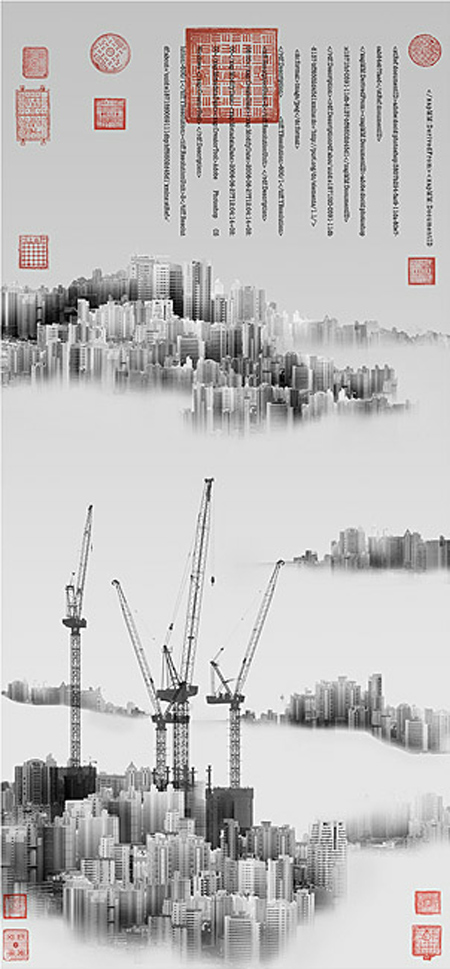
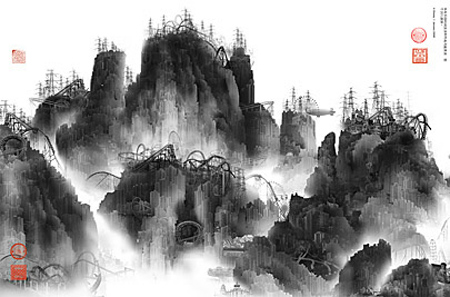
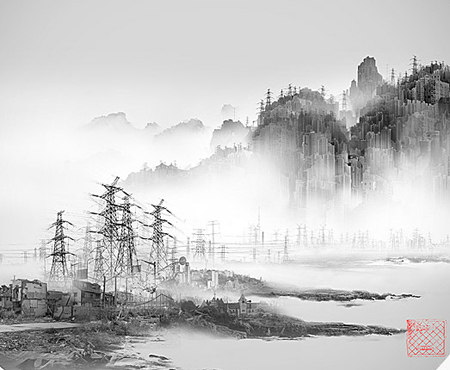


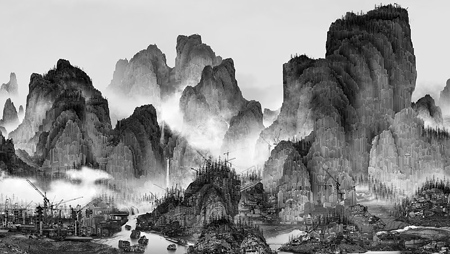
YANG YONGLIANG
| by James Watkins |
Trained in traditional Chinese painting and calligraphy, artist Yang Yongliang is pushing the boundaries of photography and landscape art with his photo-collage fusions.
Whilst navigating his website might be difficult for those of us who don’t read Chinese, Yang Yongliang’s artwork is undeniably amazing and he communicates his messages with or without google translate.
Utilising photography as the key element of his artistic works, Yang Yongliang creates artworks that require a double take to fully appreciate. At first glance nothing seems out of the ordinary in his ethereal landscapes, but on closer inspection it becomes clear that these are not just beautiful images of nature, but a harsh social commentary on the quickly evolving technological world and the rapid conquest of cities over nature.
Using a deft subtlety, Yongliang creates his photo-collage landscapes with an amazing impact. Creating beautiful photorealistic environments, using a collection of photographs of skyscrapers and other manmade structures, his stark juxtaposition of cities vs nature is a brilliantly clever approach to the often cliché artistic interpretation of nature vs technology.
To check out more of Yang Yongliang’s amazing landscapes, as well as his installation pieces (including a giant cigarette made from his trademark photo-collage) visit his website yangyongliang.com .
Words: Darcy J











Yang Yongliang by Emma Chi
When you appreciate Yang Yongliang’s work from far away, it is a graceful South Pine ink; however, when you get closer into it, you will found other scenes hind in the scenery with hills and waters: urban landscape, such as sky scrapers, traffic lights, giant crane replaced the lush woods pavilion. Even the seal mark in the angle of the picture, is also like ditch cover on the street. Who composed the traditional ink painting and modern city into a symphony? Yang Yongliang, a unique artist, he uses computer technology synthesis to combine traditional Chinese ink and picture taken in modern city. Recently, the artist's works are on display at the Bund 18 Art Gallery.

Born in late 80s in Shanghai, the artist has deep passion for traditional culture. He learned Chinese painting, calligraphy and seal carving in his early age. With specific background and learning experiences, he achieved the creation. SHIFT is honored to have an in-depth conversation and shared creative process with the artist.
Why you combining the Chinese ink painting and modern urban landscape photography together?
I learn ink painting and calligraphy since I was child. Also, living in Shanghai, probably the fastest growing city, where tremendous changes every day, I observed silently. The rises of high buildings, demolition alterations are everywhere. So naturally, I had this idea to combine what I learned in school with what I see, although there is a contradiction between two.
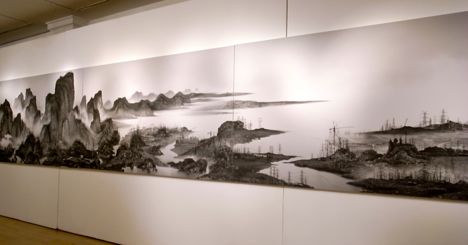
The display of a 10-meter long scroll painting is the longest piece of your work until now. How did you make the tall buildings of the modern urban into the ink scenery painting?
In my work contains two kinds of conflict: Chinese traditional culture and modern culture, and ecological environment’s contradiction between the modern city lives. People keep pursuing better and more comfortable living environment, leading to the construction of tall buildings, but the cost behind it is enormous. So look at my paintings in the distance it is harmonious natural scenery, but when you approached it can found the hidden details of urbanization indeed. I tried to reach a balance, unity contradictions to a harmony. Such as contradiction between traditional Chinese ink painting and the details of the modern city through my work, they are together, and to achieve visual balance.
China Landscape Painting reached a peak in Song dynasty. Nowadays artists think about how to success and explore, what’s your opinion?
I am afraid we could not restore and reach the ancient art creation, our social environment is different, and people's mentality could not be detached, as the ancients did. We are completely in a materialistic society, industrialization manufacturing, while people in ancient are using hand-made. First, the artistic creation of the material has been unable to reach the ancient realm. For example, silk painting, the material was a hundred percent pure silk in ancient, but most modern materials, nylon is mixed. Before the ink even could be natural drinking, people today simply could not do it anymore. So, now asks us to restore the ancient art is not possible, all conditions are not meet. In my opinion, the media what we use is not important, no matter what method you use to create maintain the creative spirit of the ancients is the most important, the kind of literati culture detached spirit. With their state of mind to appreciate the present life, we could not be lived in mountain and forest, but we can emphasize "hermit known to the world." in big cities.
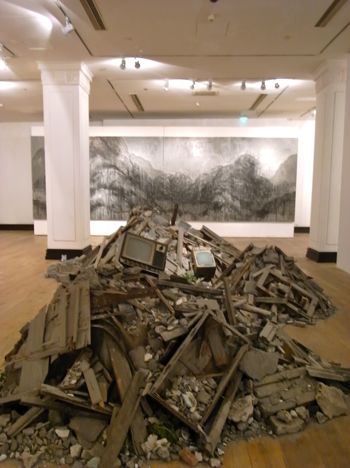
The exhibition, the artist's other theme is "cement", your device works like the brick pile as the ruins of a mountain, with clouds of dry ice spray, as if a kind of foggy in the mountain. Isn’t it an exactly another interpretation of the scenery painting?
Oh, yes, you can imagine into the mountain landscape. As the demolition alteration, discarded daily are placed on the bricks stacked everywhere into the hillside, with the cloud of cigarette smoke during the shoot, like clouds in the distance, with the painting it is paradoxical but also reach a harmonious unity.
Another amazing installation art is a popping out of the dragon, 2 meters high, 6 meters long, made of cement. Why making 'dragon'? Maybe dragon's realistic shape and huge body in particular challenges the audience's visual and emotional.
The reason why I made dragon is that dragon image is only in China. Dragon is a sacred animal in ancient times, but in my work, the dragon became a living animal, a biological. Cement production, reflecting China's current situation of housing construction, but for this social phenomenon, I do not comment, whether good or bad depend on audience own choice.
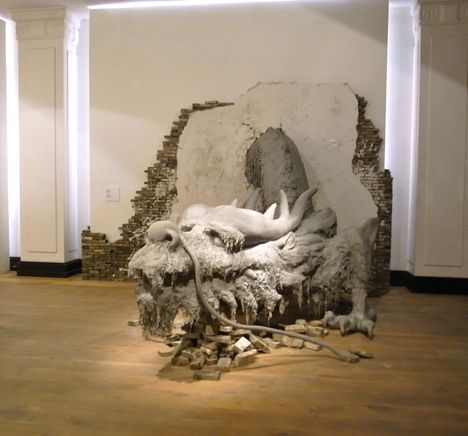
For the future, what are your plans and intentions?
Not yet decided. I like challenges, and uncertainty toward future. This is why I resigned from the studio advertising work, because I have no interest in the business, and if such work has been going, I can see the future 5 years, or even 10 years later, what my life will be. Suddenly I feel living is meaningless. So ultimately choose to invest in art creation. The future is unknown to me, and the best is that the unpredictability of the future, nothing terrible. When I die, before closing my eyes, many things will come out so vividly. I certainly think everything is worth. In short, my attitude is: earnestly to do own thing, there will always return!
Yang Yongliang Brings Chinese Landscape Painting Into The 21st Century
How does a culture steeped in ancient tradition grapple with the onset of accelerated modernity? Yang Yongliang is a Shanghainese artist who attempts to fuse traditional Chinese culture with contemporary digital techniques. Yongliang’s intricate shan shui-style digital collages of modern cityscapes, rendered in a style meant to evoke ancient Chinese landscape paintings, have turned him into an art world sensation on both sides of the hemisphere.Having trained in traditional Chinese painting and calligraphy as a child, Yongliang graduated with a design degree from the China Academy of Art and founded a successful advertising and animation studio before quitting commercial work to become a full-time artist in 2005. It was then that Yongliang began to experiment with photography, contemporary Chinese ink wash painting, and video art, gradually forming the unique style his work exhibits today, which blends spectacles of China’s fast-paced urban development with the tranquil scenery of traditional landscape paintings.

In Yongliang’s video work, Phantom Landscape, the viewer encounters what appears to be a majestic Chinese landscape painting. Looking closer, the observant onlooker will discover that the jagged surface of the rocky mountains is actually composed of densely-stacked concrete buildings. The trees aren’t trees at all but are in fact composed of construction cranes and electric towers, and misty streams flow from contaminated urban waste. The result is an ironic depiction where the nature that once served as a way for ancient poets to find inner peace is supplanted with the realities of city life and its congestion, traffic, flashy billboards, and cargo ships.
Here, Yongliang shows us a few of the original photographs he took as inspiration for his digital collages and explains how he turns photography documenting China’s rapidly-changing landscape into animated takes on classic Chinese painting. Visit his studio and learn more about his process in our behind-the-scenes video above.
The Creators Project: Can you tell us a little about how you create video from photography? What kind of tools and technology do you use?
Yang Yongliang: My videos can be seen as an extension of my photography work. They both stem from a similar concept and creative perspective, but I use slightly different software. I begin by creating a still image with many layers in Photoshop. Then I import this layered image into post-production software and replace the detailed layers with live video footage. In addition, I also used some 3D softwares to make special effects. Both [mediums] are the same to me except for the added dimension of time. This dimension makes the artwork more expansive and interesting.


Do you find some sort of similarity between the contradictory nature of organic masses and man-made environments?
Almost all of my work is trying to seek harmony between two contrary subjects. On one hand, this kind of thinking stems from tranditional Chinese philosophy, but also relates to the fact that we live our lives in a world full of conflict. Rather than being the core content, architecture and shan-shui are just some elemental components in my whole creative concept.


In your video installations, there are so many small people and cars moving within the animated paintings. What kind of stories are happening?
All of the video footage is taken with bird’s-eye view of the various places I’ve been to. During the filming process, I discovered this point of view produces an unusual experience. The viewer can step back and look at the familiar places with a completely objective view. Seeing many small people, cars, and buildings moving around at the same time can be surreal.



As an artist steeped in Chinese tradition, culture, and art, your work provides a new way to represent ancient techniques in the face of these older artforms becoming obsolete. Do you think learning Chinese paining and calligraphy is still relevant and important to people nowadays?
I think anicent Chinese art has always been a form of artistic expression detached from commericalism and functionalism. We call it “literati painting," which includes calligraphy. It resides in a system that is in opposition to the Western art system. The development of Western art focuses more on social and functional meaning. To me, Chinese art is more about having an internal dialogue, which is a side effect of self-cultivation. It’s hard for this kind of process to exist in a highly-developed commerical social structure. From a contemporary Chinese literati point of view, the original intention of self-cultivation still remains. There are still many modern literati that use Chinese painting and calligraphy to search for his or her inner character.


You are a big fan of movies, would you consider making a film?
Yes, that might be my next step. I will definitely expand into movies at some point.
All images courtesy of Yang Yongliang.



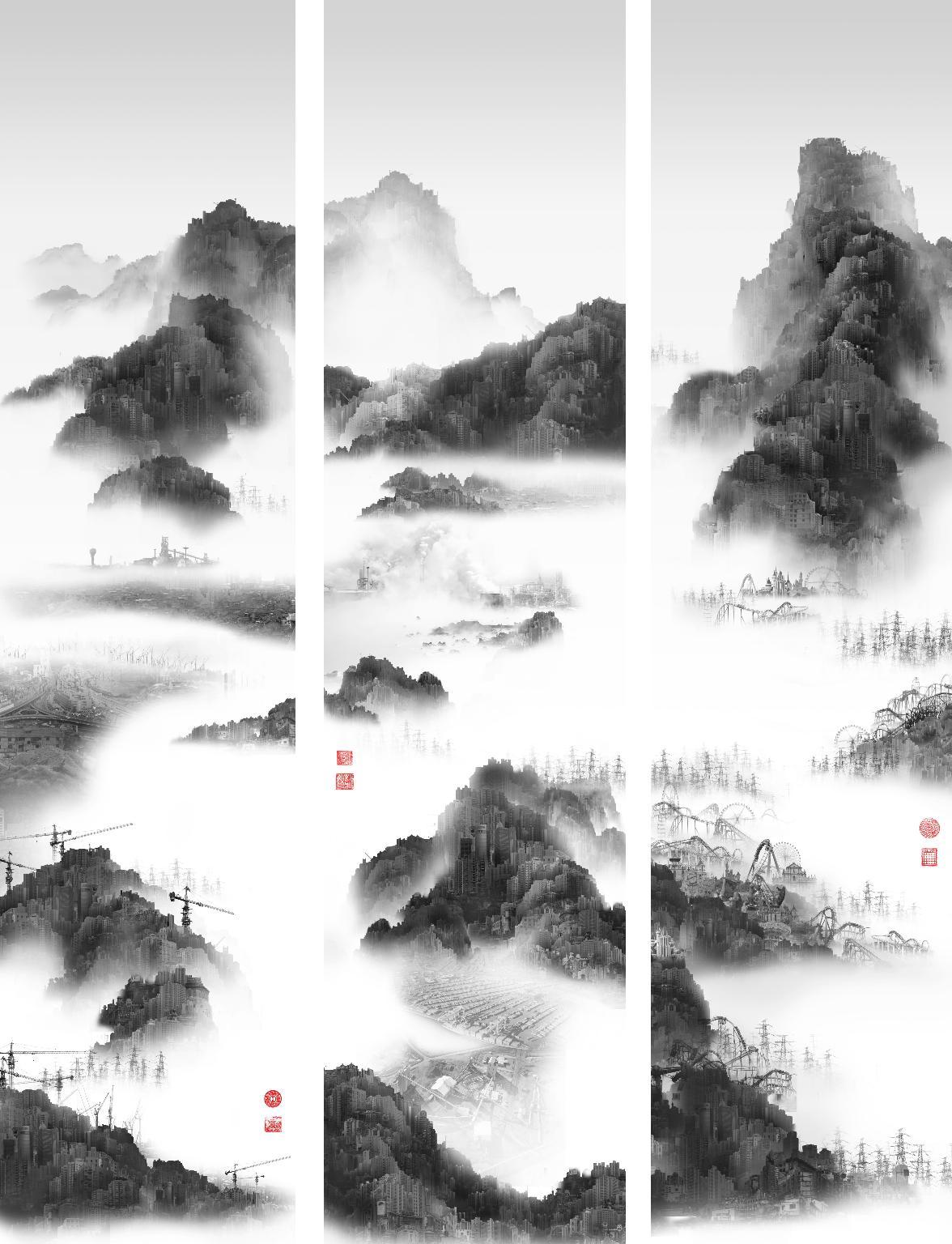













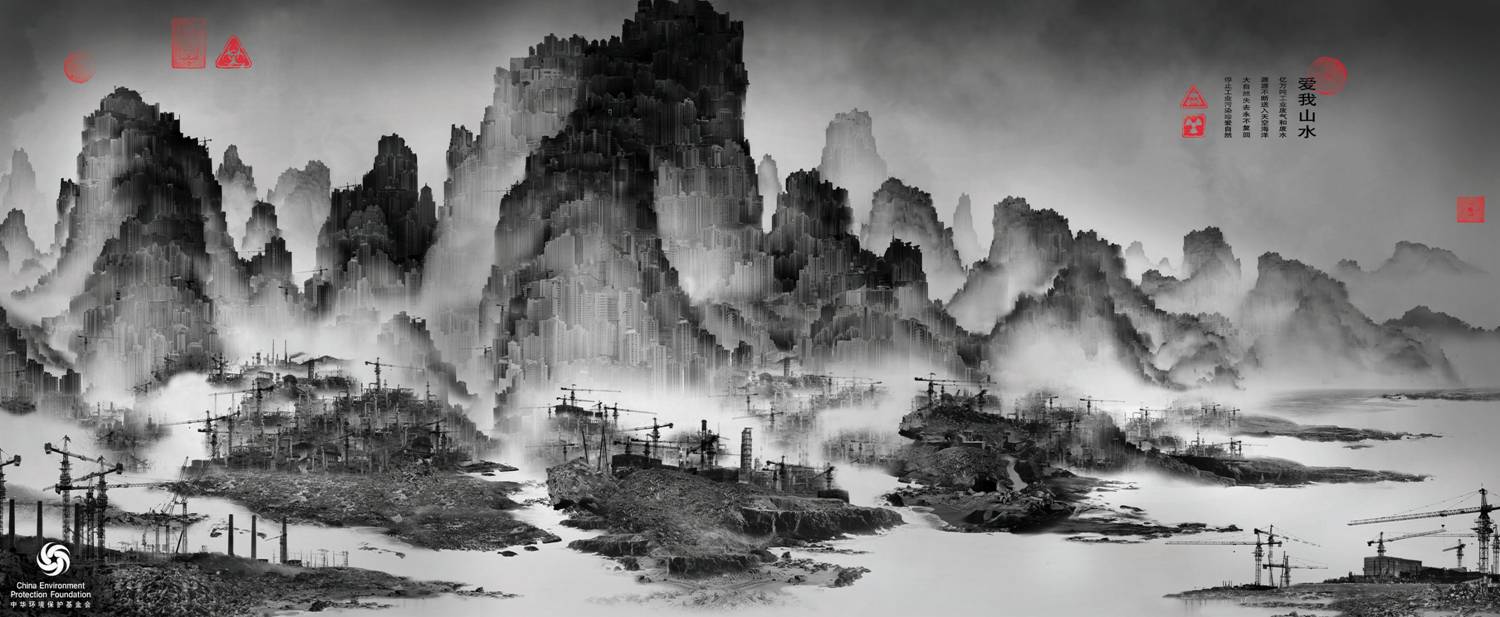


Nema komentara:
Objavi komentar